
From searching for the target of a circadian rhythm slowing molecule, to the discovery of the workings of the plant biological clock
In order to react to the day and night cycle and changing of the seasons caused by the earth’ s rotation and revolution, all living things on Earth have acquired a genetically encoded body clock, known as a circadian clock. While this evolutionary mechanism is well understood in animals, plant chromosomes multiply to two or three times their original number, and as this results in the existence of many duplicate genes (multiple identical genes in one specimen), this has been difficult to explain.
The ITbM research group succeeded in discovering a low molecular weight compound which changed the rhythm of the plant circadian clock in thale cress, a plant with a high level of gene multiplicity. They found that the target protein, the casein kinase 1 (CK1) family, was linked to the clock. Furthermore, they were able to identify the directly CK1 controlled clock-related protein, PRR. Based on this discovery, and combining the fields of biology and synthetic chemistry, they succeeded in developing a new molecule 100 times more effective than CK1, known as AMI-331.
A discovery that changes the way we think about biological clock evolution
In previously presented theories, it was thought that different kinds of organisms – bacteria, molds, animals, plants – had each developed individual biological clocks with proteins of different evolutionary origins. However, in this research, it was found that CK1 is present in plants, as well as animals and molds. In other words, this discovery suggests that there is a common protein connected to the biological clock, and should encourage a re-evaluation of current evolutionary theories related to time molecules.